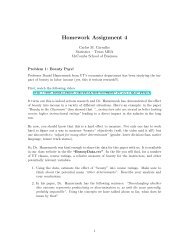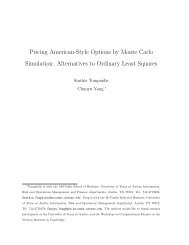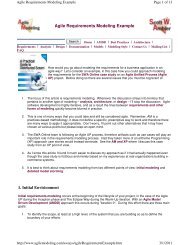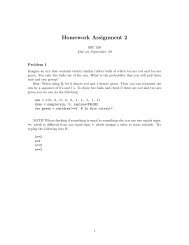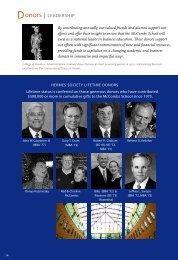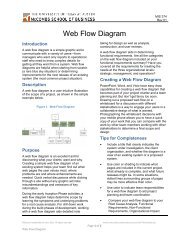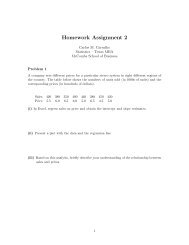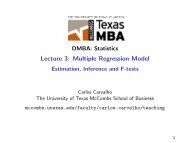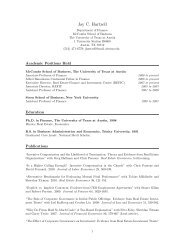Homework Assignment 1 - McCombs School of Business
Homework Assignment 1 - McCombs School of Business
Homework Assignment 1 - McCombs School of Business
- No tags were found...
Create successful ePaper yourself
Turn your PDF publications into a flip-book with our unique Google optimized e-Paper software.
<strong>Homework</strong> <strong>Assignment</strong> 1<br />
Carlos M. Carvalho<br />
Statistics – Texas MBA<br />
<strong>McCombs</strong> <strong>School</strong> <strong>of</strong> <strong>Business</strong><br />
Problem 1<br />
X ∼ N(5, 10) (Read X distributed Normal with mean 5 and var 10) Compute:<br />
(i) Prob(X > 5)<br />
(ii) Prob(X > 5 + 2 × √ 10)<br />
(iii) Prob (X = 8)<br />
(iv) Express Prob(−2 ≤ X ≤ 6) in terms <strong>of</strong> Z, the standard normal random variable.<br />
1
Problem 2<br />
For each histogram below, provide a guess for the sample average and sample variance.<br />
Density<br />
0.000 0.010 0.020<br />
Density<br />
0 50 100 150 200<br />
-20 0 20 40 60 80<br />
1.435 1.440 1.445<br />
X1<br />
X2<br />
Density<br />
0.00 0.05 0.10 0.15<br />
Density<br />
0.00 0.02 0.04<br />
-20 -10 0 10 20 30 40<br />
80 90 100 110 120 130<br />
X3<br />
X4<br />
Figure 1: Histograms<br />
2
Problem 3<br />
A company can purchase raw material from either <strong>of</strong> two suppliers and is concerned about<br />
the amounts <strong>of</strong> impurity the material contains. A review <strong>of</strong> the records for each supplier<br />
indicates that the percentage impurity levels in consignments <strong>of</strong> the raw material follow<br />
normal distributions with the means and standard deviations given in the table below. The<br />
company is particularly anxious that the impurity level in a consignment not exceed 5% and<br />
want to purchase from the supplier more likely to meet that specification. Which supplier<br />
should be chosen<br />
Mean Standard Deviation<br />
Supplier A 4.4 0.4<br />
Supplier B 4.2 0.6<br />
3
Problem 4<br />
Suppose a person is randomly drawn from a large population and then tested for a disease.<br />
Let D = 1 if the person has the disease and 0 otherwise.<br />
Let T = 1 if the person tests positive and 0 otherwise.<br />
Suppose<br />
P (D = 0) = .99.<br />
P (T = 1 | D = 0) = .01.<br />
P (T = 1 | D = 1) = .97.<br />
(a) Draw the diagram depicting the marginal <strong>of</strong> D and the conditional <strong>of</strong> T | D.<br />
(you know, the one that branches as you go left to right).<br />
(b) Give the joint distribution <strong>of</strong> D and T in the two way table format.<br />
(c) What is P (D = 1 | T = 1)<br />
4
Problem 5<br />
This problem is named after the host <strong>of</strong> the long running TV show Let’s make a deal.<br />
There has been a vigorous debate about what the correct answer is!!<br />
A contestant must choose one <strong>of</strong> three closed doors.<br />
There is a prize (say a car) behind one <strong>of</strong> the three doors.<br />
Behind the other two doors, there is something worthless (traditionally a goat).<br />
After the contestant chooses one <strong>of</strong> the three doors, Monty opens one <strong>of</strong> the other two,<br />
revealing a goat (never the car!!).<br />
There are now two closed doors.<br />
The contestant is asked whether he would like to switch from the door he intially chose, to<br />
the other closed door.<br />
The contestant will get whatever is behind the door he has finally chosen.<br />
Should he switch<br />
5
Problem 6<br />
After finishing your MBA and becoming a consultant you will be flying for meetings regularly!<br />
Say you’ll be traveling routinely to Boston, Orlando, Philadelphia and San Diego...<br />
Also, you like to accumulate miles with both Delta and US Airways and you are trying to<br />
decide which airline will minimize potential delays. After a quick look on-line you find in<br />
the U.S. Bureau <strong>of</strong> Transportation Statistics the following probability table describing the<br />
delays <strong>of</strong> these two airlines:<br />
Delta US Airways<br />
Delayed 20% 22%<br />
On Time 80% 78%<br />
Is this enough information for you to make a decision If not, can you explain a possible<br />
scenario in which choosing Delta doesn’t make sense<br />
6
Problem 7<br />
Here’s a simplified look at a spam filter algorithm...<br />
We are worried about the term “Nigerian general” and our IT team has figured that<br />
pr(“Nigerian general”|junk mail) = 0.20 and pr(“Nigerian general”|NOT junk mail) = 0.001<br />
In addition they figured that half <strong>of</strong> our emails is junk.<br />
1. What is the marginal probability <strong>of</strong> seeing “Nigerian general” in a message<br />
In other words, what is the pr(“Nigerian general”)<br />
2. If the spam filter always classify a message containing “Nigerian general” as junk,<br />
how <strong>of</strong>ten will it make a mistake<br />
In other words, what is the pr(NOT junk mail|“Nigerian general”) <br />
7
Problem 8<br />
A credit card company has launched a new UT affinity card and its marketing group is<br />
proposing sending out pre-approved applications to all UT alumni. The company needs<br />
to figure out, estimate, two key quantities that will play a role in the pr<strong>of</strong>itability <strong>of</strong> this<br />
operation: (i) the proportion <strong>of</strong> people that will return the application and (ii) the expected<br />
monthly balance these folks will carry in their new card. Let’s call the first quantity p and<br />
the second quantity µ.<br />
In trying to estimate these quantities the company decided to send a preapproved applications<br />
to a random sample <strong>of</strong> 1,000 alumni. Of those, 14% accepted the <strong>of</strong>fer. In addition,<br />
after 3 months, the average monthly balance in the card for those who accepted the card<br />
was $1,990 with a standard deviation <strong>of</strong> $2,833.<br />
With this information, what has the credit card company learned about p and µ (hint: I<br />
already now that the best guess for p is 14% and for µ is $1,990!)<br />
8
Problem 9<br />
I decided to invest $100,000 in the S&P500 for one year. You are my financial advisor and I<br />
need you to estimate a plausible range for my investment by the end <strong>of</strong> the one-year period.<br />
(Hint: I dont know, you are my financial advisor, so go figure it out!! :) )<br />
9



